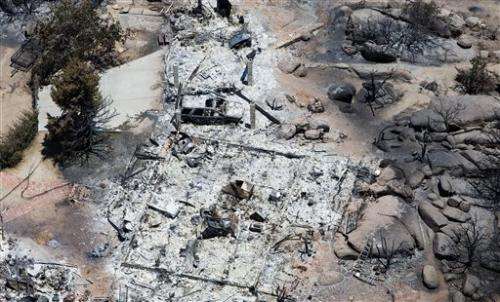Experts: Expect bigger, fierce wildfire in US West (Update)

There's a dangerous but basic equation behind the wildfire that killed 19 Arizona firefighters and other blazes raging across the American West this summer: More heat, more drought, more fuel and more people in the way are adding up to increasingly ferocious fires.
Scientists say a hotter planet will only increase the risk.
More than two dozen wildland fires are burning from Alaska to New Mexico, fueled by triple-digit temperatures and arid conditions. In the Arizona mountain town of Yarnell, a blaze apparently sparked by lightning killed 19 members of an elite firefighting squad who had deployed their emergency shelters Sunday when erratic monsoon winds sent flames racing in their direction.
While no single wildfire can be pinned solely on climate change, researchers say there are signs that fires are becoming bigger and more common in an increasingly hot and bone-dry West.
"Twenty years ago, I would have said this was a highly unusual, fast-moving, dangerous fire," said fire history expert Don Falk at the University of Arizona at Tucson, referring to the Yarnell Hill fire. "Now unfortunately, it's not unusual at all."
Wildfires are chewing through twice as many acres (hectares) per year on average in the United States compared with 40 years ago, U.S. Forest Service Chief Tom Tidwell told a Senate hearing last month. Since Jan. 1, 2000, about 145,000 square miles (375,550 square kilometers) have burned, according to federal records.
A draft federal report released earlier this year said climate change is stressing Western forests, making them more vulnerable to fires.
What's happening now "is not new to us," said climate scientist Don Wuebbles of the University of Illinois, one of the main authors of the federal report. "We've been saying this for some time."
Compared with decades past, the traditional fire season now lasts two months longer and first responders sometimes find themselves beating back flames in the winter.
Rising temperatures all over the West, for one, have created dangerous, dry conditions.
Over the past 35 years, Arizona has seen dramatic warming, with the state's 10-year average temperature jumping from 59.1 degrees Fahrenheit (15 Celsius) in 1977 to 61.4 degrees (16.33 Celsius) last year. Experts say every little spike in temperature makes a big difference.
"Even a degree or so warmer, day in day out, evaporates water faster and that desiccates the system more," said fire ecologist Steve Running of the University of Montana.
In many places, decades of aggressively snuffing out wildfires also have led to a buildup of fuel ready to ignite. On top of that, more people are living in fire-prone areas near forests, grasslands and shrub lands, which complicates firefighting logistics.
Climate scientist Jonathan Overpeck of the University of Arizona said unless greenhouse gas emissions are curbed, huge, fierce wildfires will become the norm.
Governments also need to rethink the way they deal with fires, which could mean just letting some burn rather than sending fire crews into increasingly intense and unpredictable situations, said University of Montana fire scientist and elite firefighter Carl Seielstad.
"I think it's inevitable," he said. "We're going to have to accept defeat when we're defeated."
As residents across the West learn to cope, scientists point to the Nobel Prize-winning Intergovernmental Panel on Climate Change, which in 2007 predicted that warmer summer temperatures were expected to increase fire risk.
Six years later, "we keep seeing more and more amazing fire dynamics," the University of Montana's Running said. "And there's just no reason to believe overall that this is going to go back ... We better be ready for more of it."
More information:
National Interagency Fire Center: www.nifc.gov
Draft National Climate Assessment: ncadac.globalchange.gov
Arizona State Climate office: azclimate.asu.edu/index.php
© 2013 The Associated Press. All rights reserved.




















